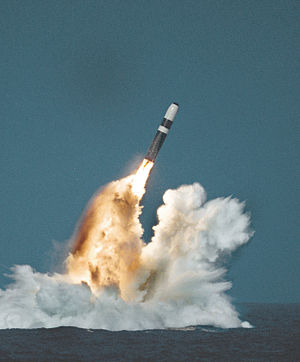三叉戟II型弹道导弹
来自维基百科,自由的百科全书
UGM-133A三叉戟II型弹道导弹,又称三叉戟D5是一款潜射弹道导弹(SLBM),由洛克希德·马丁公司位于加州森尼韦尔的空间系统公司研发制造,装备美国以及英国海军。三叉戟II型于1990年首次服役[4],是三叉戟I型的改进型号,打击精度更高,载荷、航程也均有增加。是美国核三位一体重要的一环,也是美国核威慑重要的组成部分。三叉戟II型是具有威慑力的海基弹道导弹,也是美国在新削减战略武器条约的谈判过程中有力的筹码。由于弹头载荷的增大,美国军方只需要更少的核潜艇就能达成同样的核威慑力[10],且由于及精度很高,接近陆基弹道导弹,三叉戟II型可用于一次打击。[11][12][13]
| UGM-133A三叉戟II型弹道导弹 | |
|---|---|
 | |
| 类型 | 潜射弹道导弹 |
| 原产地 | |
| 服役记录 | |
| 服役期间 | 1990年 |
| 使用方 | 美国海军 英国海军 |
| 生产历史 | |
| 生产商 | 洛克希德·马丁 |
| 单位成本 | $3732万美元 (2014年)[1] |
| 生产日期 | 1983年 |
| 基本规格 | |
| 重量 | 130,000磅(59,000千克)[1] |
| 长度 | 44英尺6.6英寸(13.579米) |
| 直径 | 6英尺11英寸(2.11米)(第一级)[1] |
| 弹头 | 8至12枚W88型或W76型氢弹分导式多弹头[2][3] |
| 爆炸当量 | - 每枚W88型弹头47.5万吨当量 - 12枚W88型弹头合共570万吨当量 |
| 发动机 | 3具固体火箭发动机 [4] |
| 推进剂 | 硝酸酯, 聚乙二醇[5] |
| 作战范围 | 超过12,000公里(7,500英里)[6][7](具体作战范围没有公布)[8] |
| 速度 | 时速约29,020公里(18,030英里),24马赫,每秒8060米[1] (末端速度) |
| 制导系统 | MK6型导弹制导,由GPS引导定位[1][9] |
| 转向系统 | 单具矢量推力[5] |
| 精度 | - MK6弹头精度不明 - MK5弹头精度约90米[7] |
| 发射平台 | 弹道导弹潜艇 |
战备
目前搭载三叉戟II型的潜艇有14艘美国海军的俄亥俄级核潜艇以及4艘英国海军前卫级核潜艇,每艘俄亥俄级能搭载24枚,前卫级能搭载16枚(因美俄签署了新削减战略武器条约,俄亥俄级把搭载数量减少到20枚)。1989年设计完成后,已经有161次成功的试射。[14]最近一次试射由俄亥俄级内布拉斯加号于2018年3月执行。[15]另外大约有少于10次的发射失败[16],上一次发射失败是2016年6月份,英国皇家海军前卫级复仇号潜艇_(S31)发射三叉戟II型失败[17]。2002年美国海军公布延寿计划, 三叉戟II型预计将服役至2040年。[18]
参考资料
Wikiwand - on
Seamless Wikipedia browsing. On steroids.
